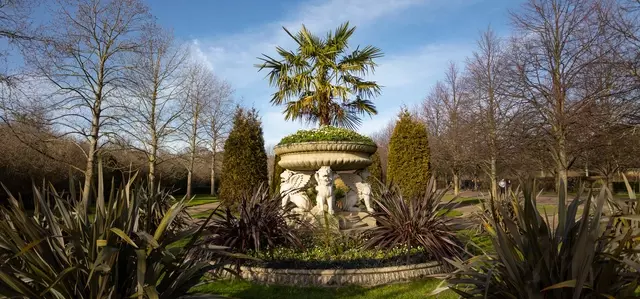
Welcome to The Regent's Park & Primrose Hill
Slow down and smell the roses. Or work up a sweat. Grab a slice of culture or a slice of cake. Watch the birds or take in that famous view from Primrose Hill. There’s something here for everyone.
Key information
The history and architecture of The Regent’s Park
Home of Regency architecture, scientific endeavour – and 40,000 glorious roses.
The jewel in the crown – The Regent’s Park
The Regent’s Park that we know today is the high water mark of Regency elegance. Designed by John Nash in the early 1800s, the park is a masterpiece of landscape design and town planning, as well as an enduringly beautiful green space.
The early days of The Regent’s Park
Originally, the parkland was part of the vast forest of Middlesex and known as Marylebone Park, after the nearby village and manor. Marylebone Park was thickly wooded, and full of deer.
This caught the eye of King Henry Vlll. Not content with hunting at Richmond Park, Hyde Park and St. James’s Park, King Henry seized the 554 acres of Marylebone Park to add to his royal collection of hunting grounds. A ditch and rampart kept the deer in, the poachers out – and Henry happy.
And so Marylebone Park remained. Between 1649 and 1660, as many as 16,000 trees were chopped down and land sold off to pay for the Civil War. For the next 150 years the park was leased to tenant farmers.
But it was destined to become one of the most sought-after neighbourhoods in London.
Grand designs in the 1800s – The Prince Regent and John Nash
By 1811, London and its population were growing – and there was more money to be made by building on Marylebone Park than by farming it. At the same time, the new Prince Regent set his heart on a new summer palace with its own exclusive grounds. He turned to celebrated architect, John Nash.
Nash’s bold landscaping design featured a vast, rounded park surrounded by highly desirable Regency residential villas, plus a stunning summer palace for the Prince Regent and a processional road linking this new palace with the prince’s other home, St. James’s Palace.
Nash was a brilliant architect, but no businessman. The plans didn’t make a small fortune – they cost one. And the Prince Regent simply lost interest. Only 8 villas were built and the Prince’s summer Palace never materialised, but the processional route survives as Regent Street today.
The 1800s – becoming a Royal Park
At first, the only people allowed in the park were the exclusive residents themselves, and the fashionable 'carriage set' who took part in weekly carriage rides. But in 1835, the east side the park opened to the public.
Science and the arts in The Regent’s Park
The Regent’s Park has a flourishing cultural life. In 1838, The Royal Botanic Society laid out the Inner Circle with lawns and a lake, now the site of the world-famous rose collection in Queen Mary's Gardens. The Regent’s Park is also home to the world’s oldest scientific zoo, London Zoo, and the oldest outdoor theatre in the world.
The history of Primrose Hill
One of the best views in London can be enjoyed from the top of Primrose Hill. In Roman times, the hillside was a wolf-infested forest, but by the 1400s, the forest had given way to meadows and open fields. Its name changed to Primrose Hill in Elizabethan times, due to the glorious spring flowers on its slopes. Primrose Hill became Crown property in 1841, and eventually linked to The Regent’s Park below it.